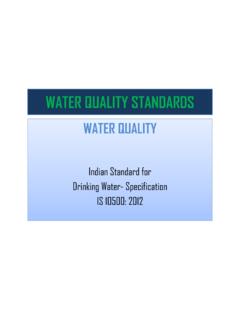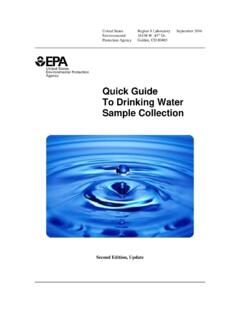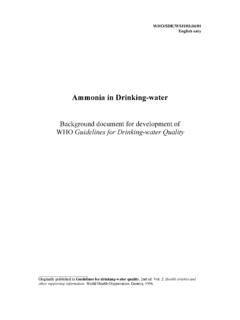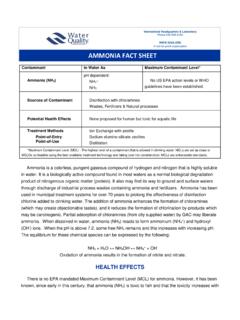Transcription of Chemicals in Drinking Water: Chloramines
1 Chemicals in Drinking water : Chloramines 1 Background Information 2 Exposure Routes & Standards 3 Metabolism & Toxicity Information 4 Health Effect Information 5 Sources of Information & Acknowledgements 1 Background Information chemical names Inorganic Chloramines : Monochloramine NH2Cl & formulae Dichloramine NHCl2 Trichloramine (nitrogen trichloride) NCl3 Organic Chloramines : R-NHCl where R=organic group CH3, C2H5 Monochloramine should be recognised as being different from commercial products called chloramine T, chloramine B and dichloramine T.
2 These products are sodium salts of chlorinated arylsulphonamides and are used as antibiotics or germicides in human medicine and as veterinary topical antiseptics and disinfectants. They are not approved for use in potable water supplies in the UK and are not formed as by-products in Drinking or recreational water . Description Chloramines are products of the reaction between ammonia (NH3) and chlorine (Cl2). The Chloramines speciation depends on the relative amounts of NH3 and Cl2 present: NH3 + Cl2 NH2Cl + HCl (favoured when the ratio of Cl2 : NH3 is 3-5 : 1) + Cl2 NHCl2 + HCl (favoured when Cl2 : NH3 is 5-7 : 1) + Cl2 NCl3 + HCl (favoured at higher Cl2.)
3 NH3 ratios) pH ranges Monochloramine is the first member of the homologous series and is the principal product formed at pH However, higher chlorine concentrations in the water and lower pH results in the formation of di- and tri-chloramine. Acidic Neutral Basic 1 2 3 4 5 6 7 8 9 10 11 12 13 14 tri-CA di-CA mono-CA Public Drinking water supplies 1 Chloramines are formed as a result of the reaction between added chlorine and ammonia naturally present in the water or ammonia that has been deliberately added so that a combined chlorine residual will be formed.
4 Terminology When results of water analysis refer to: Combined residual chlorine concentration, this denotes chlorine in the form of Chloramines . Free residual chlorine concentration, this denotes chlorine in the form of hypochlorous acid (HOCl) and the hypochlorite ion (ClO-). Uses Monochloramine can be used as a disinfectant in water supplies and has the advantage of creating fewer by-products than when chlorine itself is used. Chlorination results in the formation of trihalomethanes (THMs) which are potentially hazardous and can cause taste and odour problems at high concentrations.
5 Areas of the US, Canada and Britain have used monochloramine as a disinfectant for several decades and have demonstrated, in model distribution studies, it to be an effective inactivator of biofilm bacteria due to its greater penetrating power compared to free chlorine. Monochloramine is used as a disinfectant at concentrations that typically range from to mg / L. The primary disadvantage of monochloramine is that it is a much weaker and slower acting disinfectant than free chlorine. It is particularly weak at inactivating certain viruses.
6 In water systems that use monochloramine as a residual disinfectant, chlorine is usually used as a primary disinfectant so that microorganisms, including viruses, will be exposed to the free chlorine for a suitable period. Ammonia is then added at a point downstream from the initial chlorine application and the monochloramine is formed in-situ which then persists for longer period than free chlorine. A potential problem with the use of monochloramine is nitrification, caused by the action of ammonia-oxidising bacteria on excess ammonia from incorrect dosing.
7 Removal Chloramines can be removed from water using activated carbon with low flow rates (5 to 10 minutes contact time), followed by residual ammonia adsorption using mineral zeolite media. The use of reducing agents such as sodium sulfite, sodium bisulfite, sodium thiosulfate and ascorbic acid (vitamin C) also removes monochloramine from water . Boiling and aeration are ineffective methods for monochloramine removal. 2 Exposure Routes & Standards Drinking water Chloramines are present both in chlorinated water and potentially as vapour above the surface of the water .
8 Typical chloramine concentrations of 2 mg / L are found in Drinking water supplies where monochloramine has been used as a primary disinfectant or to provide a chlorine residual in the distribution system. Whilst there is no UK standard for Chloramines in water , the WHO recommend a maximum acceptable concentration for Chloramines in Drinking water of 3 mg / L (rounded figure). This is based on a tolerable daily intake (TDI) of monochloramine of 94 g / kg body weight which itself is derived from a no observable 2adverse effect level (NOAEL) of mg / kg body weight divided by a safety factor of 100.
9 The US EPA reconsidered the toxicity data for monochloramine when establishing a Maximum Residual Disinfectant Level Goal (MRDLG) and Maximum Residual Disinfectant Level (MRDL) for Chloramines in Drinking water which entered US legislation in 1998. The evaluation was based on the abovementioned NOAEL and determined the MRDLG and MRDL to be 4 mg / L (as Cl2) equivalent to 3 mg / L monochloramine. Household Accidental mixing of solutions of ammonia and sodium hypochlorite bleach cleaning agents (NaOCl) results in the production of monochloramine and dichloramine fumes which are acrid and irritant.
10 Swimming pools Chloramines are present in swimming pool water and in the atmosphere of the pool-hall as by-products from the reaction of ammonia (derived from the decomposition of urea and creatinine in nitrogenous human products urine and sweat) with chlorine-based disinfectants. The Pool water Treatment Advisory Group recommend the concentration of free chlorine detectable (free chlorine residual) be kept as low as 1 mg / L and that the combined chlorine residual should be ideally half, or less, of that of free chlorine.








